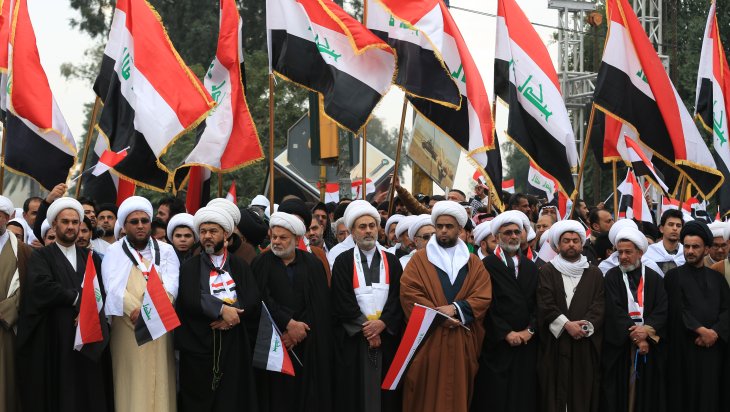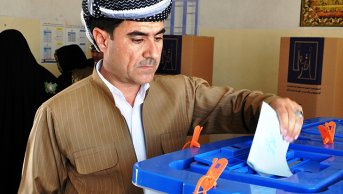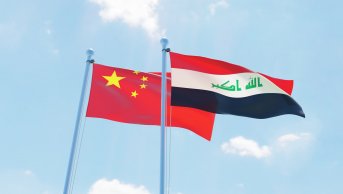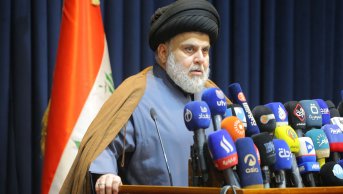Muqtada al-Sadr’s motives on anti-US protests in Iraq

Upon the call of Muqtada al-Sadr, the popular leader of the Sadr Movement, a protest was held on 24 January in Baghdad, the capital of Iraq, calling for the removal of US forces from the country. In addition to the Sadr supporters, thousands of members of the Hashd al-Shaabi and supporters of the militia groups participated in the anti-US protests in the Jadriyah region of Baghdad. Sadr made an appearance in the protests held in Iraq, where the anti-government demonstrations that have been going on since October 1 have resulted in the resignation of Prime Minister Adil Abdul-Mahdi, and that the new prime minister has not been elected yet and the demands of the street have not been met. It can be seen that Sadr takes advantage of Iraqi identity, and sends a message to Baghdad, Tehran, and Washington administrations that he is one of the strongest decision-making mechanisms in Iraq.
Muqtada al-Sadr, son of Shiite religious leader Ayatollah Mohammed Sadiq al-Sadr, who has a respectable place in the Shiite world, became one of the most influential religious and political figures in the country after the death of his father and two siblings in 1999. Sadr inherited the political-religious activity of his family, which is and has been respected by the Shiite world up to the Saddam era and since that time. Sadr may mobilize many regions in the south of the country, such as the Sadr City of Baghdad with a population of about 2 million people, and the poor Shiite class. Benefiting from the spiritual memory stemming from the love of a significant part of the poor regions for his father and making good use of the Iraqi nationalist rhetoric and the network of relations inherited from his father, Sadr quickly consolidated his power in the streets and the political realm. Establishing the Mahdi Army during the US invasion of Iraq in 2003 and opposing the US presence in the country, Sadr gathered around himself the Shiites, who put forward their Iraqi identity against the Shiite groups that agreed with the US and were uncomfortable with Iran's activity in the country. As a matter of fact, Sadr's Sairoon Coalition, which gradually increased in politics after the 2010 elections, took first place in the May 2018 elections by having 54 deputies and became coalition partners. Sadr gained the sympathy of a significant number of Shiites, used his influence among them in the political field as a trump card and wants to demonstrate his strength on the street from time to time, as he did in the past.
Instrumentalizing the anti-US Attitude
By making use of popular movements and discourses in Iraq, Sadr instrumentalizes these elements. After the killing of Commander of the Quds Force affiliated to the Iranian Revolutionary Guards, Qasem Soleimani, and the Hashd al-Shaabi Commission's deputy head, Abu Mahdi al-Muhandis, in the US airstrike carried out in an airport in Baghdad on 3 January, the long-standing debate about the US presence in the country flared up again. In this context, the Iraqi Parliament convened on 5 January at short notice with the participation of only Shiite lawmakers and accepted the proposal of the Iraqi government demanding the removal of foreign troops from the bases in Iraq. Willing to turn this atmosphere into an opportunity, Sadr called for a protest to symbolize that the society and politicians did not want US soldiers on Iraqi soil. In the protests where some participants wore white shrouds, protesters shouted slogans such as “No to the US, no to invaders, yes to sovereignty!” The fact that Sadr, one of the most powerful symbols of the anti-American resistance in the country since 2003, has recently brought up the idea of reviving the Mahdi Army, who fought against the US during the invasion, can be attributed to the anti-US sentiment that emerged after the Soleimani assassination. Recalling that, in January 2019, the Sairoon Coalition, led by Sadr, prepared a draft law along with the Fateh list, led by Hadi al-Amiri, known for his proximity to Iran and former Prime Minister Nouri al-Maliki’s State of Law Coalition for the removal of the US and other foreign powers from the country it can be thought that Sadr wants to keep his policy on the removal of US troops alive. From this point of view, it is understood that even if the US presence in the country will continue, Sadr wants to keep this social mood alive and to use it for political purposes.
Iraq-Centered Search for Politics in US-Iranian Tension
Ayatollah Ali al-Sistani, the biggest religious authority of the Iraqi Shiites, has given instructions to his followers not to join the anti-US protests organized by Sadr. However, the participation of Asa’ib Ahl al-Haq leader Qais al-Khazali and Badr Organization leader, Hadi al-Amiri, who are known for their closeness to Iran within the Hashd al-Shaabi, as well as the supporters of the Hashd al-Shaabi led to discussions that the protests were carried out in line with Iran’s expectations. As a matter of fact, after the murder of Muhandis, Sadr came to the forefront as the strongest candidate in filling the gap by reacting most to the US airstrikes and calling for the establishment of “international resistance forces”. In this context, a series of talks with leaders of Iraqi militia groups led by Sadr such as the Nujaba Movement, Kata'ib al-Imam Ali and Kata'ib Sayyid al-Shuhada in the Qom province of Iran were considered to be messages against the United States. The protests Sadr organized by mobilizing a large audience satisfied Tehran and pro-Iranian Iraqi groups and even some Iran TV channels did broadcast the protests live. However, despite his recent rapprochement with Tehran, Sadr continued to vary his character and his political attitude and made statements showing that he was not very much connected with a single pole. As a matter of fact, in his message read by Kazim Isavi, the military assistant of Sadr, during the protests, the Shiite leader declared that he suspended the resistance against the United States by saying “all foreign powers should withdraw from the country. We temporarily stop the resistance until the last foreign troop leaves Iraq,” and added, “Hashd al-Shaabi should be combined with the Ministries of Defense and Interior”. His remarks that “if this is not done, Hashd al-Shaabi, which is part of the security mechanism, must comply with all the decisions of the Armed Forces Commander (Prime Minister)” appear to have disappointed Tehran and pro-Iranian groups in Iraq. By this move, it can be stated that Sadr used his political power against other political actors at critical times, instead of radicalizing as an anti-US actor, he sent a message that he wanted to balance both Iran and the US by adopting a more Iraq-centered political stance. In addition, Sadr, who wants foreign countries not to interfere with Iraq's internal affairs in the political and economic fields, calls for the government to sign an agreement with neighboring countries to make them respect Iraqi sovereignty, which may be interpreted as a message to Iran. On the other hand, it can be held that Sadr's request for the government to protect foreign missions in the country and to punish those who attack them is a message to the Hashd al-Shaabi supporters and Iran which attacked the US Embassy in Baghdad on 31 December.
Having a strong image as the leader of the resistance against the US invasion and expressing from time to time his discomfort about Iran's hegemony in Iraq, Sadr tries to position himself as the anti-status quo leader of an Iraqi nationalist reform movement. Indeed, his desire not to see any flag belonging to any group but an Iraqi nationalist flag in the anti-US protests organized by his call can be understood as one of Sadr’s attempts to address his Iraqi identity. Although it has been trying to survive on a fragile ground following the 2003 US invasion and prompted the Shiite groups to adopt different positions, the Iraqi identity has recently strengthened in Iraq and become more evident in the anti-government protests that have been going on in the country since October 2019. As a matter of fact, 97 percent of the participants who joined the al-Mustakilla Research Group’s interviews in Baghdad and the cities in the south of the country between 24 November and 1 December stated that their participation in the protests made them more proud of being Iraqi citizens. It is known that Sadr is taking this potential into account and trying to back protesters. For, the rising anti-Iran and Iraqi identity in the protests provided a suitable atmosphere for Sadr's ideas; nevertheless, Sadr’s relationship with the pro-Iranian groups and his appearance in Tehran in every opportunity attract the reaction of the protesters. However, this situation has damaged his relationship with the groups that are on the streets to protest the government. In this respect, Sadr might have also wanted to show that he could create an alternative spirit with the anti-US protests.
Sadr’s Power to Mobilize Masses
Sadr has demonstrated his ability to mobilize masses of people on the streets of Iraq through a protest involving thousands of people. His power to mobilize masses is thought to be a message to all political groups in Iraq as well as to Tehran and Washington, which are quite active in Iraq. While a new prime minister so far could not be determined, especially due to the failure of Sadr and pro-Iranian groups to agree with one another, with his potential being recognized in the protests he organized, the leader of the largest group in the parliament, Sadr, could be given more right to speak to determine the prime minister. The pro-Iranian Kata’ib Hezbollah and the Nujaba Movement, which are at the center of the reflection of the US-Iranian tension in Iraq, threatened Iraqi President Barham Salih not to meet with US President Donald Trump in Davos. Yet Sadr supported Salih for his talks and remarks in Davos and called him “the protector of the constitution and sovereignty”. Salih, on the other hand, made a statement on his social media account, supported the anti-US protests organized on Sadr's call and shared the photograph of the protests. He also mentioned the possibility of his resignation as the pro-Iranian groups insisted on the candidacy of Basra Governor Asad al-Idani for the prime ministerial post. This may empower Sadr’s hand in determining the prime minister in the new period. Aware of the fact that no leader other than Sadr can organize such big protests, Salih may be expected to consider the requests of Sadr, who has proved his power to mobilize masses in the protests.
Sadr's Effect upon Anti-government Protests
Sadr’s anti-US protests have driven anti-government demonstrations into a new phase. Sadr’s decision not to “interfere” with the anti-government protests any longer led to discussions leading to such that the protests came to an end and that Sadr had a mission in this regard. It has even come to the agenda that Sadr has agreed with the government and pro-Iranian groups to withdraw his important support for anti-government protests. In this context, it was observed that the supporters of the Sadr Movement started to gather up their tents and put an end to their demonstrations in the squares of Baghdad, Basra, and Maysan and that the security forces opened the roads closed beforehand by the protesters and dispersed the protesters in some regions. In addition, the efforts of Iraqi security forces, who plan to end anti-government protests, burned tents near the Tahrir Square, which is the center of the demonstrations, and used tear gas to disperse the protesters from the region; all these are associated with Sadr’s withdrawal of support from the protests. Considering the intense contribution of Sadr supporters in anti-government protests, and following Sadr's announcement that he would withdraw his support, the protests have come to a halt. In addition, Sadr-led protests have brought back to the agenda the disproportionate violence and pressure against anti-government protests that have been going on for more than three months. While the anti-US protests, which were carried out by Sadr’s call, were peaceful, two people were killed the same day in the anti-government protests during which 600 people died in total. This is regarded to be significant in terms of providing an example of how the security elements in Iraq respond to the protests of various political movements. After Sadr’s announcement to withdraw his support, the violent attitude of the security forces towards anti-government protesters drew attention. In this context, the allegations that Sadr betrayed the street and served Iran’s interests may increase in the coming period.
In conclusion, Sadr showed both Iran and the US that he was the strongest figure of the Shiite population in Iraq in the anti-US protests he organized on January 25. From this perspective, Sadr’s role as a balancing actor in the Tehran-Washington tension in the new period may not be surprising. After the killings of Soleimani and Muhandis, Sadr’s struggle to be accepted by Tehran as the only interlocutor of the Shiites in Iraq and to increase his effectiveness on the Hashd al-Shaabi may become a current issue. Considering President Salih’s opposition to pro-Iranian groups that were against his meeting with Trump and his statements in the protests that disturb Tehran, Sadr’s relations with Iran may be strained in the coming period. In addition, it seems likely that Sadr, who has proven his power to mobilize masses again, will be the most effective actor in the determination of the new prime minister and the government and his influence upon the government will increase. However, with Sadr’s decision to withdraw support, the anti-government protests are almost over and yet, the protesters who have been waiting for the government to address their demands for months will increase and any government in which Sadr is involved will cause suspicion.








